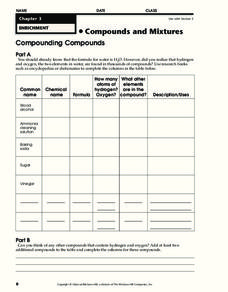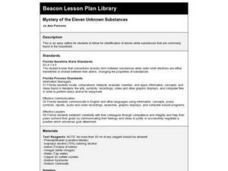Curated OER
Nomenclature Worksheet
In this chemical compounds worksheet, students write the correct chemical name for the given formulas and then write the correct chemical formula for the given compounds. This worksheet has 30 problems to solve.
Curated OER
Types of Chemical Reactions
For this chemical reactions worksheet, students are given directions about three types of reactions and how to write balanced equations for each. They then are given ten practice problems to complete using the information given.
Curated OER
Types of Chemical Reactions
In this chemical reactions activity, high schoolers read about the 3 types of chemical equations and how to write balanced ionic equations. Students are given 5 equations to balance, write the type of reaction, write the total ionic...
Curated OER
Compound Names and Formulas
In this chemistry worksheet, students identify 12 compounds based on their chemical formulas and write chemical formulas for 12 additional compounds.
Curated OER
Compounds
In this chemistry instructional activity, students complete a chart about common compounds. Examples include baking soda, sugar, and wood alcohol.
Curated OER
Chemical Compounds
In this chemical compounds worksheet, students write the name for 10 chemical formulas and then determine the formula from the names of 10 different chemical compounds. This worksheet has 20 fill in the blank questions.
Curated OER
Review - Naming Chemical Compounds
In this compounds worksheet, learners name the given chemical compounds and write the formula for other chemical compounds. This worksheet has 20 problems to solve.
Curated OER
50 Ways to name Your Compound
In this compounds worksheet, learners review the rules for naming compounds. Students apply these rules by writing the chemical name or formula for the 50 compounds given.
Curated OER
Characterizing Drosophila Mutants
Students investigate wild-type and several mutant varieties of Drosophila melanogaster, which are characterized and distinguished according to pteridine pigments. They discoverthat paper chromatography of the wild-type Drosophila results...
Curated OER
Predicting and Naming Polyatomic Ionic Compounds Worksheet
In this compounds worksheet, students write the polyatomic ionic compound formulas or the compound names. This worksheet has 29 problems to solve.
Curated OER
Displacement Reactions and Acid/Base Reactions
In this chemical reactions worksheet, students review the solubility rules for common salts. Students determine the molecular equation, ionic equation, and net ionic equation for specific reactions. Students calculate moles and volume...
Curated OER
Worksheet for Identifying Types of Acids and Bases
In this acid and base learning exercise, students fill in a table with the type of acid or base and the symbol used in calculations. Types of acids and bases identified include strong acids, weak acids, strong bases, weak bases, Lewis...
Curated OER
Chemistry - Naming and Formulas
In this compounds worksheet, students name the given compounds from its chemical formulas and write the chemical formula from the compound name. This worksheet has
Curated OER
Identifying Types of Acids and Bases #2
In this acid and base learning exercise, students fill in a table given acids and bases and identify the type of acid or base it is and the symbol used in calculations.
Curated OER
Mass-Mass Problems
For this chemical reactions worksheet, students calculate the grams of product from a given amount of reactants. This worksheet has 7 problems to solve.
Curated OER
Chemical Analysis and Stoichiometry
In this chemical analysis worksheet, students use a combustion analysis report to calculate the empirical formula for compound samples. This worksheet has 2 problems to solve.
Curated OER
Chemical Analysis and Stoichiometry Problem Set
In this chemical analysis worksheet, students calculate the empirical formula using a combustion analysis report. Students write balanced chemical equations, total ionic equations, and net ionic equations. This worksheet has 2 problems...
Curated OER
Chemical Equations
In this chemical equations worksheet, students fill in the blank with information about how to form chemical equations using the "ide" rule and the "ate" rule.
Curated OER
Precipitation and Neutralization Reactions
In this chemical reactions worksheet, students determine the balanced formula equation, balanced complete ionic equation, and the balanced net ionic equation for given reactions. Students calculate final concentrations for ions in given...
Curated OER
Using the Stock System
In this compounds worksheet, students learn the rules for naming compounds, the stock system. Students apply these rules by writing the names or formulas for the 20 given compounds.
Curated OER
Acids, Alkalis, and Salts
In this acids worksheet, high schoolers review the definition of acids, bases, and salts. Students describe the differences between acids and alkalis and define neutralization. This worksheet has 2 short answer and 1 problem to solve.
Curated OER
Mystery of the Eleven Unknown Substances
Fourth graders identify eleven white substances that are commonly found in the household. They, in pairs, perform experiments on a variety of substances, and must identify them based on the reactions they observe.























